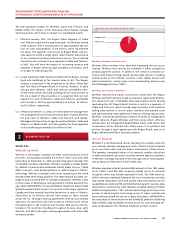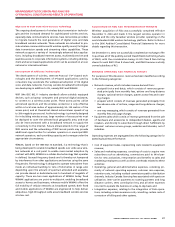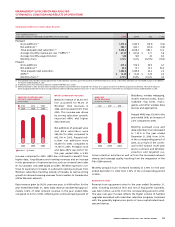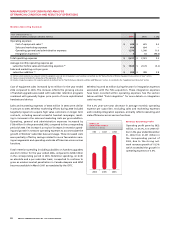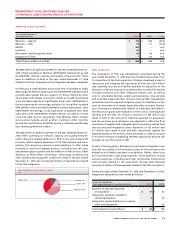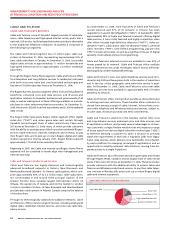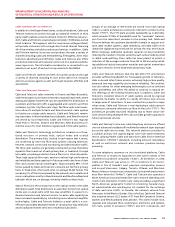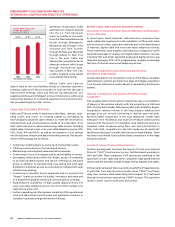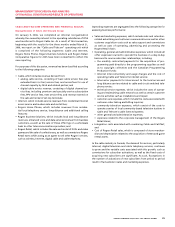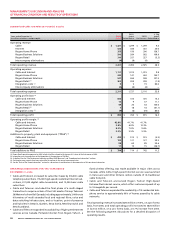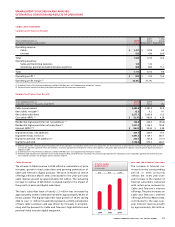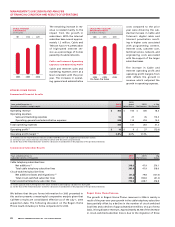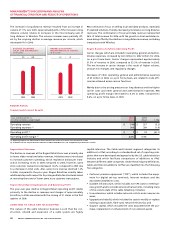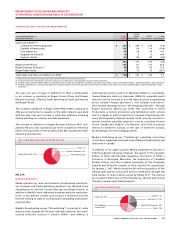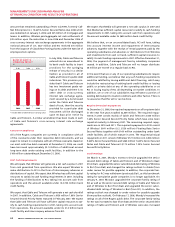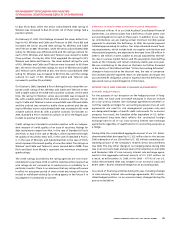Rogers 2006 Annual Report Download - page 39
Download and view the complete annual report
Please find page 39 of the 2006 Rogers annual report below. You can navigate through the pages in the report by either clicking on the pages listed below, or by using the keyword search tool below to find specific information within the annual report.
35
RO GER S CO MMU NIC AT ION S IN C . 20 0 6 ANN UA L RE POR T
MANAGEMENT’S DISCUSSION AND ANALYSIS
OF FINANCIAL CONDITION AND RESULTS OF OPERATIONS
CABLE AND TELECOM OPERATING AND FINANCIAL RESULTS
Reorganization of Cable and Telecom Group
On January 9, 2006, we completed an internal reorganization
whereby the ownership interest in the operating subsidiaries of RTHI
was transferred to Rogers Cable Inc. As a result of this transaction,
beginning with the results for the three months ended March 31,
2006, we report on the “Cable and Telecom” operating unit which
is comprised of the following segments: Cable and Internet,
Rogers Home Phone, Rogers Business Solutions and Rogers Retail.
Comparative figures for 2005 have been reclassified to reflect this
new reporting.
For purposes of this discussion, revenue has been classified according
to the following categories:
• Cable, which includes revenue derived from:
• analog cable service, consisting of basic cable service fees plus
extended basic (or tier) service fees, and access fees for use of
channel capacity by third and related parties; and
• digital cable service revenue, consisting of digital channel ser-
vice fees, including premium and specialty service subscription
fees, PPV service fees, VOD service fees, and revenue earned on
the sale and rental of set-top terminals;
• Internet, which includes service revenues from residential Internet
access service and modem sale and rental fees;
• Rogers Home Phone, which includes revenues from residen-
tial local telephony service, long-distance and additional calling
features;
• Rogers Business Solutions, which includes local and long distance
revenues, enhanced voice and data services revenue from business
customers, as well as the sale of these offerings on a wholesale
basis to other telecommunications providers; and
• Rogers Retail, which includes the sale and rental of DVDs and video
games and the sale of confectionary, as well as commissions Rogers
Retail earns while acting as an agent to sell other Rogers’ services,
such as wireless, Internet, digital cable and cable telephony.
Operating expenses are segregated into the following categories for
assessing business performance:
• Sales and marketing expenses, which include sales and retention-
related advertising and customer communications as well as other
customer acquisition costs such as sales support and commissions
as well as costs of operating, advertising and promoting the
Rogers Retail chain;
• Operating, general and administrative expenses, which include all
other expenses incurred to operate the business on a day-to-day
basis and to service subscriber relationships, including:
• the monthly contracted payments for the acquisition of pro-
gramming paid directly to the programming suppliers as well
as to copyright collectives and the Canadian Programming
Production Funds;
• Internet interconnectivity and usage charges and the cost of
operating Cable and Telecom’s Internet service;
• Intercarrier payments for interconnect to the local access and
long distance carriers related to cable and circuit-switched tele-
phony service;
• technical service expenses, which includes the costs of operat-
ing and maintaining cable networks as well as certain customer
service activities such as installations and repair;
• customer care expenses, which include the costs associated with
customer order-taking and billing inquiries;
• community television expenses, which consist of the costs to
operate a series of local community-based television stations in
Cable and Telecom’s cable licenced systems;
• other general and administrative expenses;
• expenses related to the corporate management of the Rogers
Retail stores;
• Integration costs associated with combining Cable and Call-Net;
and
• Cost of Rogers Retail sales, which is composed of store merchan-
dise and depreciation related to the acquisition of DVDs and game
rental assets.
In the cable industry in Canada, the demand for services, particularly
Internet, digital television and cable telephony services, continues
to grow and the variable costs associated with this growth, such as
commissions for subscriber activations, as well as the fixed costs of
acquiring new subscribers are significant. As such, fluctuations in
the number of activations of new subscribers from period to period
result in fluctuations in sales and marketing expenses.


